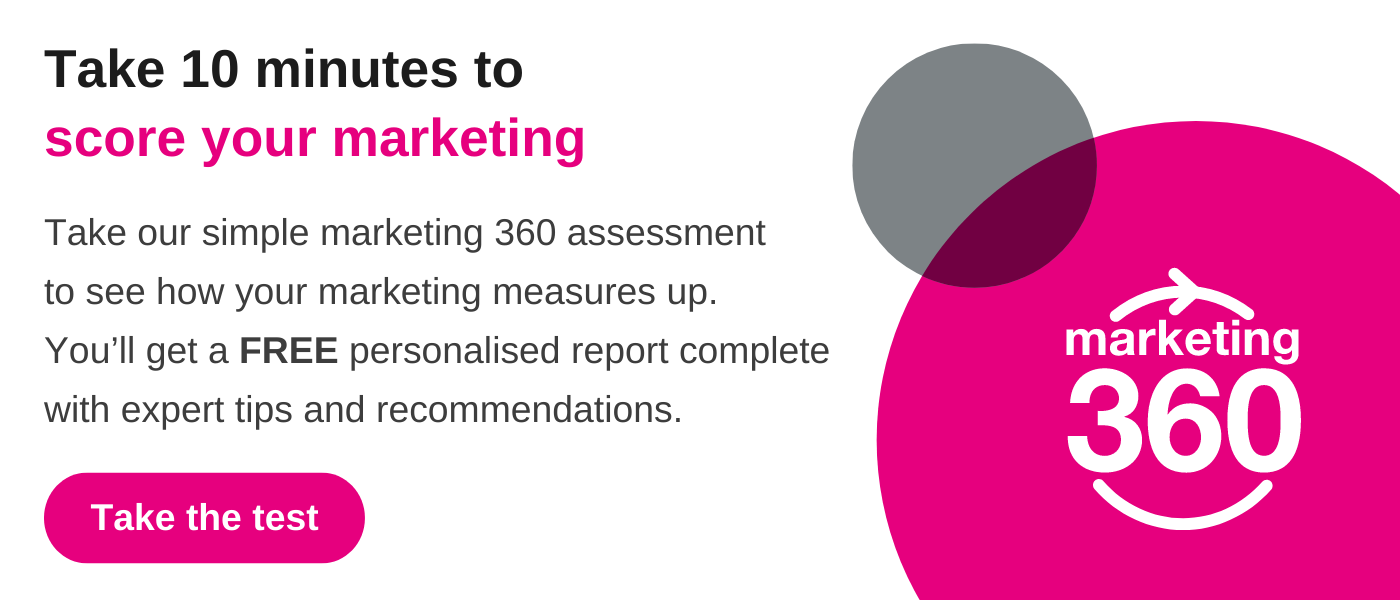Welcome to the third article in our series on lead generation: Lead Gen in 10. The premise is simple. Quickfire, practical, hands-on exercises that will improve every aspect of your lead generation process.
So far we’ve shown you how to define what a ‘good’ lead is for your business and calculate how many of them you need to hit your sales targets. Now we’re going to look at tried-and-tested tactics for generating sales leads.
But before we get into the things you can do, you need to ask yourself an important question...
What kind of leads do you want?
If you sell a lot of low-price goods or services, your lead generation approach will be different from a company that sells a small number of high-value items. The smaller the number of sales you need, the more targeted your approach is likely to be.
Exercise two in this series will help you understand whether you need a large number of small sales or a small number of large sales. Make sure you check it out before getting into specific tactics.
Want 4 more ways to improve your lead generation?
Our Lead Gen in 10 workbook will give you five useful exercises to improve every aspect of your lead generation.
11 tried-and-tested ways to generate leads
Cold emails and calls
Cold email is considered quite unfashionable in some quarters. But for many businesses - including our own - it can still generate quality opportunities when done right.
Any kind of cold outreach is only as good as the list you have and how you approach contacts. You need targets that have a problem you can help with and you need to approach them in a way that starts a conversation.
Remember, you’re probably not trying to get them to commit to a meeting straight away. You just want to get them talking and, if possible, add some value. Creating personalised or highly-targeted content can be a good way to do this. If you’re looking for some advice on how to create content that prospects will value, check out our learnings from seven years of creating content.
Ultimately, it’s all about tone. If you start any conversation with, ‘you don’t know me, but please buy my stuff,’ it’s not going to go well.
LinkedIn organic & Sales Navigator
LinkedIn Sales Navigator is another great way to find leads and make contact. You can use it to build laser-targeted lists of new contacts and share relevant, valuable content with them via InMail. LinkedIn says Sales Navigator is 75% more effective than emails and calling (although they would say that).
Don’t forget, you get 20 free InMails per month as part of your Sales Navigator subscription. Most salespeople forget to use them!
Sales Navigator is just one side of LinkedIn. You can also use LinkedIn to build an audience and drive awareness of your business.
People on LinkedIn don’t want to interact with brands, they want to interact with people. Business owners who are visible and active on LinkedIn will attract potential customers. Those that aren’t will miss out.
Some people find posting content a bit intimidating. If you’re the same, check out our list of 44 different writing prompts for awesome LinkedIn content. It will give you everything you need to start sharing your journey on LinkedIn and building relationships with potential customers.
LinkedIn, Facebook or Adwords ads
Buying social or PPC ads can be a great way to reach your entire market with targeted offers. That said, if you don’t go about it the right way, it can also be a quick way to lose money. Buying clicks is usually easy, but getting the right people to click and carry on the conversation is the real challenge.
While the platforms have made it possible to ‘self-serve’, working with a specialist who knows what they’re doing will improve your likelihood of success. Trying to save money by working it out for yourself can be a false economy.
Events, seminars and webinars
Offline and online events are a tried-and-tested way to meet potential customers. We recently wrote about how we’ve used webinars to drive more than 2,000 signups over the last 12 months. If it works for us, it could work for you.
A common mistake that people make is to think a lot about the subject matter, but not enough about the follow-ups and next steps. Your event and follow-ups should push people onto the next step in the buyer journey. You can find loads more tips on running successful webinars in the link above.
‘Old and cold’ leads in your CRM
Most businesses have a lot of stalled opportunities in their CRM. These leads may feel like a lost cause, but it’s usually easier to re-energise a previous opportunity than create a totally new one.
The final exercise in this series will show you how to find and target existing opportunities in your CRM. If you’re looking for something more detailed, here’s a step-by-step guide that will help you find, re-energise and close old leads.
Self-assessment tools
Our Marketing 360 self-assessment is a good example of a self-assessment tool. It asks our potential customers a series of questions and gives them personalised content that helps them understand their marketing strengths and weaknesses. We link to it throughout our website and regularly in our content marketing. Over the last 12 months, it’s generated 150 new leads.
If you’re going to build a self-assessment tool, there are a few things to consider. First, make sure it’s adding genuine value for the user. No one wants to spend time filling out a questionnaire to be told stuff they already know. Second, don’t forget to make it easy to find and use throughout your website and beyond - on social media, email footers, webinars and beyond.
People won’t find it for themselves!
Gated content
Gated content is a form of content marketing where you ask for your customers’ contact details in return for high-value information such as original research or a step-by-step guide. We have a lot of gated content on our website.
It works particularly well if you pair it with your blog. For instance, in every blog post, we link from our freely-available content to our gated content, giving us a shot at converting anonymous website traffic into known contacts. We then contact them via email or phone to continue the conversation and build the relationship.
You can see an example of this below.
B2B Lead Generation: Step-by-Step Guide
Get our complete guide to generating, nurturing and converting leads.
Download the guide.
Referrals from existing customers
Referrals are powerful. Leads that come through a recommendation usually close faster than leads that find you online because some of the selling is already done.
The best way to get referrals is straightforward: ask for them. Customers who really value your service will often be happy to refer you on, but they’re unlikely to do it without some kind of nudge. If necessary, you can even incentivise referrals by offering some kind of referral scheme.
Get more advice on earning referrals from your existing customers.
Leads from partners
Distributors, resellers and retailers are a great source of leads. But they usually require a bit of elbow grease to start delivering.
You can find some great advice on how to get more value from your existing partners and how to find new ones in our previous article on increasing revenue.
Website optimisation
Everyone wants more traffic to their website. But are you generating the right traffic and doing enough to convert that traffic once it’s on your website? A lot of SMEs make the mistake of focusing almost entirely on generating traffic and ignoring converting that traffic into sales opportunities, often called ‘conversion rate optimisation’ or CRO for short.
Conversion optimisation is a deep and complex subject. But there are a few simple things you can do to get more conversions:
- Include testimonials from happy customers and case studies throughout your website to reassure visitors you can deliver on your promises
- Make it easy for people to contact you by email and phone or via simple forms and webchat
- Invest in an attractive and usable website design - good design is a trust signal! You also need to make sure it looks good on mobile as that will be the entry point for an ever-increasing share of your visitors
- Focus your web copy on who you help and how you help them rather than telling people what you are, eg. ‘we help SME business owners grow their companies’ is better than ‘we do marketing’
- Place call-to-actions throughout your website encouraging visitors to take the next step on the customer journey - you have to tell people what you want them to do next
Direct mail
Direct mail tends to be more expensive than digital channels because of the cost of distribution and production. It’s harder to do in the age of remote work, but it can still work. In fact, if you pick your targets wisely it can be spectacularly effective as there are fewer people doing it.
Finding the approach that’s right for you
Not every approach on this list will be a perfect fit for your business. But hopefully they’ve given you some idea of the options available. You don’t need to try all of them at once, just pick one or two that you think are a good fit for you and your customer.
This is the third exercise in our Lead Gen in 10 series. For more exercises to help you close more new business from your lead generation activity, check out the other exercises below:
- What’s a ‘good’ lead for your business?
- How many leads do you need to hit your revenue targets?
- The sales and marketing activities you need to push leads through the funnel faster
- How to re-energise 'old and cold' sales opportunities in your CRM
Or click here to get the entire series in one handy workbook.
Find the gaps in your marketing
If you've followed all the exercises in this series your lead gen should already be picking up. But there's more to marketing than just lead generation.
Our Marketing 360 assessment will help you identify other potential issues and offer advice on how to solve them.




